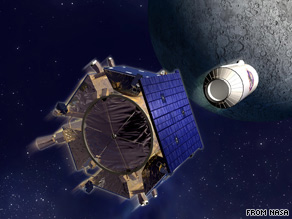
|  |  |  Editorials | Environmental | October 2009 Editorials | Environmental | October 2009  
NASA's Strike on Moon Worked, Mission Official Says
 CNN CNN
go to original
October 10, 2009


| | An artist's rendering shows the LCROSS spacecraft, left, separating from its Centaur rocket. |  |
NASA said Friday's rocket and satellite strike on the moon was a success, kicking up enough dust for scientists to determine whether or not there is water on the moon.

"We have the data we need to actually address the questions we set out to address," said Anthony Colaprete, principal investigator for the Lunar Crater Observation and Sensing Satellite, or LCROSS, mission.

It will be awhile before all the data from the satellite can be analyzed to determine if there is water on the moon, according to LCROSS project manager Dan Andrews.

Andrews said that "the spacecraft performed beautifully."

NASA crashed the rocket and a satellite into the moon's surface on Friday morning in a $79 million mission.

NASA televised live images of the LCROSS as it crashed into a crater near the moon's south pole.

Minutes before its impact, the satellite guided a rocket into the Cabeus crater in an effort to kick up enough dust to help the LCROSS find whether there is any water in the moon's soil.

The Centaur upper-stage rocket impacted the moon shortly after 7:30 a.m. ET, and the satellite followed it four minutes later.

The LCROSS carried spectrometers, near-infrared cameras, a visible camera and a visible radiometer to help NASA scientists analyze the resulting plumes of dust - more than 250 metric tons' worth - for water vapor.

But immediate NASA images of the crash produced no sign of the plumes, which were expected to rise six kilometers from the moon's surface, said John Marmie, LCROSS deputy project manager.

"Everyone was like, 'What's happening here?' " Marmie said. "But that doesn't mean we don't have good data there."

Observatories on Earth did confirm they saw plumes after the crashes, Marmie said.

The orbiting Hubble Space Telescope and NASA's Lunar Reconnaissance Orbiter photographed the impacts. Meanwhile, hundreds of telescopes on Earth focused on the moon, hoping to catch a glimpse of two plumes.

The Cabeus crater lies in permanent shadow, making observations inside the crater difficult.

NASA Deputy Administrator Lori Garver, who watched at a public event at the Newseum in Washington, noted the great interest in the NASA mission.

"We had families ... literally coming in off the street" to watch, Garver said on NASA TV.

NASA had encouraged amateur astronomers to join the watch parties.

"We expect the debris plumes to be visible through midsized backyard telescopes - 10 inches and larger," said Brian Day at NASA's Ames Research Center at Moffett Field, California, before the strike. Day is an amateur astronomer who is leading education and public outreach for the LCROSS mission.

Ames - which led the mission - hosted an all-night event featuring music and food before the broadcast of NASA's live transmission of the lunar impact.

Other science observatories and amateur astronomy clubs across the country hosted similar events.

"The initial explosions will probably be hidden behind crater walls, but the plumes will rise high enough above the crater's rim to be seen from Earth," Day said.

Data from previous space missions have revealed trace amounts of water in lunar soil. The LCROSS mission seeks a definitive answer to the question of how much water is present. NASA has said it believes water on the moon could be a valuable resource in the agency's quest to explore the solar system.

LCROSS launched with the Lunar Reconnaissance Orbiter aboard an Atlas V rocket from Cape Canaveral, Florida, on June 18. |

 |
|  |



